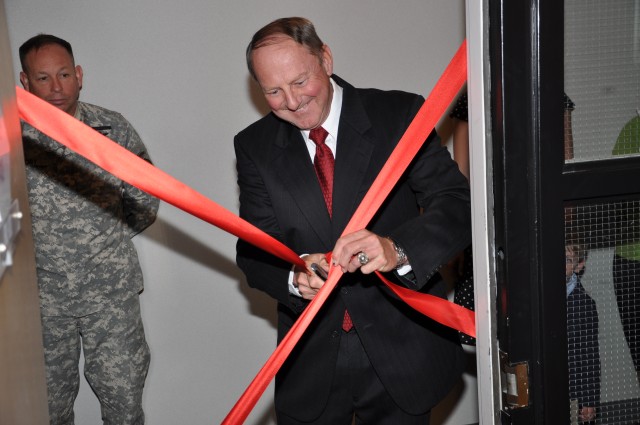A ribbon cutting ceremony officially christened the beginning of a new directorate within the Future Warfare Center in the U.S. Army Space and Missile Defense Command/Army Forces Strategic Command (USASMDC/ARSTRAT) on Oct. 1, 2010 in Colorado Springs, Colo. The ceremony also marked the opening of expanded office space for the directorate.
As a result of reorganization within the Future Warfare Center, the new Directorate of Training and Doctrine assumed responsibility for training and doctrine for space and missile defense - specifically ground-based midcourse defense - operations within the Army. Previously, this responsibility fell to the Center's Directorate of Combat Development. The reorganization aligned training and doctrine for space and missile defense related jobs with a standard U.S. Training and Doctrine Command structure.
Terry Nelson, director of the newly created directorate, said the new organization will significantly enhance the command's professional readiness in conducting space and ground-based midcourse defense operations. As its own organization, Nelson said, the new directorate is better suited to support USASMDC/ARSTRAT and Army institutional training missions while meeting Army-wide education and doctrinal needs.
"We will continue our emphasis on training Soldiers to the highest standard prior to deployment to Operation Enduring Freedom, Operation New Dawn and to other locations worldwide," he said. "To the extent our resources allow, we'll bring improved access to the Army space cadre and missile defense professionals and continue to pursue opportunities within the Army's Institution of Excellence."
Under the new arrangement, the directorate is now responsible for translating space and missile defense training and leader development requirements into institutional training and leader development programs. The directorate assesses the effectiveness of Army-wide space and missile defense training, education, activities, and products and provides Army-wide education to Soldiers of all ranks and civilian workforce.
The directorate has three divisions:
Collective Training and Doctrine Division - Responsible to train and develop the workforce, create collective training products, and develop doctrine for all Army space, Ground-based Midcourse Defense and High Altitude systems.
Space Training Division - Responsible to provide training courses for all Army Space Operations Officer in Functional Area 40; Army Space Support Teams and Space Support Elements at division, corps and Army levels; Army Space Cadre at the basic level; and Joint Tactical Ground Station (JTAGS) operators. Additionally, the division is responsible for leader development courses for space professionals. The division also maintains the command's space literacy program and has responsibility for space curriculum development support for other Army branches, proponents, the Army War College, Command and General Staff College, and Joint space training. They also provide instructors to the National Security Space Institute and the Advanced Space Operations School.
Missile Defense Training Division - Responsible to provide training courses for all Ground-based Midcourse Defense operators, master gunners and command launch equipment operators, and AN/TPY-2 (FMB) sensor managers at the qualification level. The division also is responsible for leadership development and executive courses.
Nelson said creating the new directorate utilizes personnel assigned within the Directorate for Combat Development prior to the reorganization. He expects a positive effect on the efficiency of space, missile defense, combat development operations and institutional training requirements.
The reorganization left responsibilities for space capabilities, missile defense capabilities, and force development to the Directorate of Combat Development, Nelson said. That directorate's mission will be to coordinate and execute USASMDC proponent responsibilities for space, Ground-based Midcourse Defense and High Altitude. The directorate also ensures USASMDC/ARSTRAT concepts and requirements are translated into doctrine, organization, training, materiel, leadership and education, personnel and facility solutions to support the Warfighter.
A major contributing factor in the reorganization is that the Army continues to transform to meet current and future threats and missions, Nelson said. Also, USASMDC/ARSTRAT must continue to reevaluate its organizational structure to ensure it meets these requirements to better support the Warfighter.
The increased awareness from these mission areas required a correlating restructuring of existing organizational elements to provide the highest level of support, Nelson said. He cited the fact that institutional training courses offered by USASMDC/ARSTRAT have increased from one basic FA40 Space Operations Officer Qualification Course in 2001 to 20 Space and Ground-based Midcourse Defense-related courses. Mission growth has lead to the continued curriculum development which will provide over 30 courses in the next two years.
Nelson said that the newly formed Directorate of Training and Doctrine allows for more effective management process for doctrine, training, leadership and education.






Social Sharing